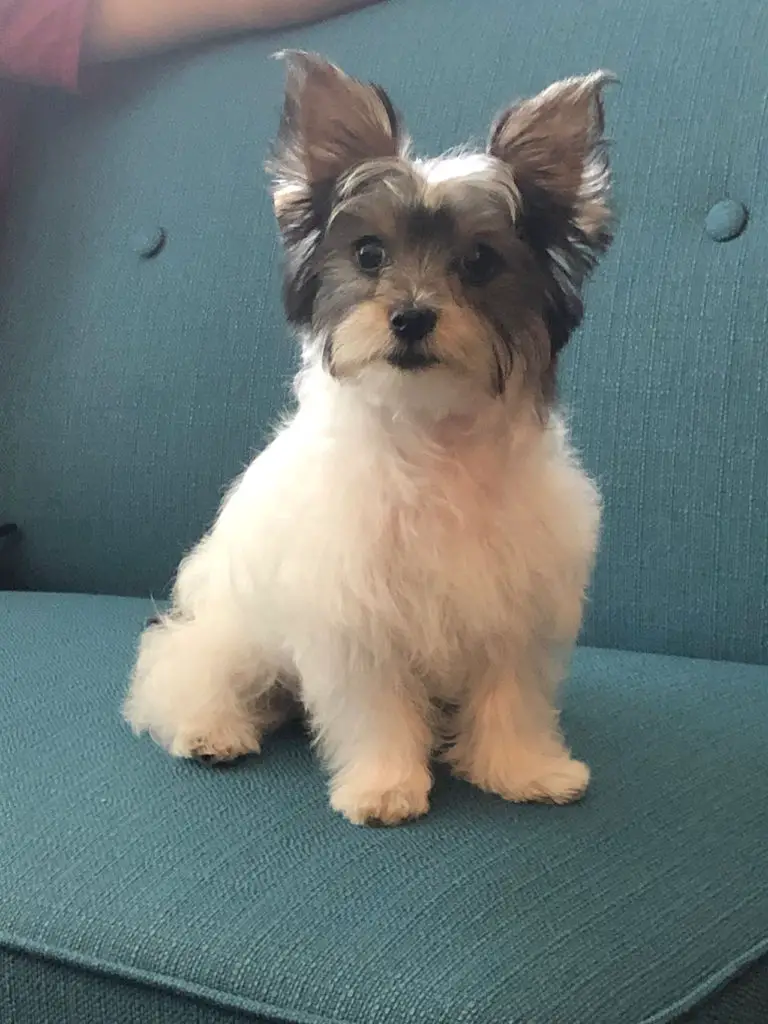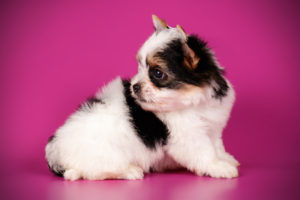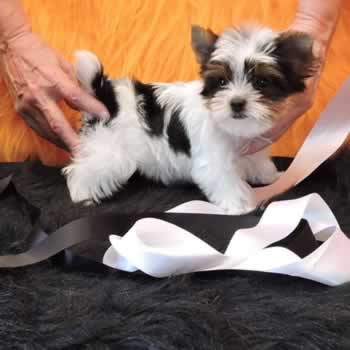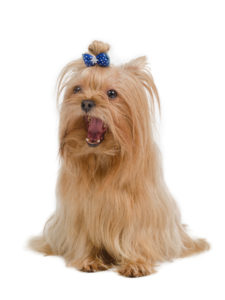Parti Yorkies
Parti Yorkies
You’re probably familiar with the standard Yorkshire Terrier coat colors: gold and blue. Yorkies actually come in a huge array of colors, however, some of which are recognized by the AKC. One of the most unique types of Yorkie is the Parti Yorkie. If you’ve ever seen a white Yorkshire Terrier with tan and black, you’ve seen a Parti.
Here’s what makes a Parti Yorkie so unique.
What Is a Parti Yorkie?
Strictly speaking, Parti Yorkies are nothing more than purebred Yorkshire Terriers, only with a difference in their coloring. Where standard Yorkshire Terriers have blue and tan colored hair, Parti Yorkies will be black, white, and tan in color.
It’s also possible to find other color combinations occurring in the Parti Yorkie breed, such as a black and white Yorkie, a white Yorkie, a blonde Yorkie (or Golden Parti Yorkie), and a chocolate Parti Yorkie.
So, what is a Parti Yorkie? Any Yorkie with significant white patches or white colors combined with black and gold is considered a Parti Yorkie. A Parti Yorkie can also have golden or chocolate colors, although that’s less common.
Are Parti Yorkies Purebred?
 Once considered low quality by breeders and experts, and often euthanized or given away, as of 2000, the Parti Yorkie is now officially recognized by the American Kennel Club (AKC). Due to the belief that the Parti Yorkie was a result of Yorkshire Terriers being mated with Maltese and other dogs for numerous reasons — such as in an attempt to improve features such as the length and texture of the Yorkie’s coat — many critics believed that the color of the Parti Yorkie is a leftover from non-Yorkie stock.
Once considered low quality by breeders and experts, and often euthanized or given away, as of 2000, the Parti Yorkie is now officially recognized by the American Kennel Club (AKC). Due to the belief that the Parti Yorkie was a result of Yorkshire Terriers being mated with Maltese and other dogs for numerous reasons — such as in an attempt to improve features such as the length and texture of the Yorkie’s coat — many critics believed that the color of the Parti Yorkie is a leftover from non-Yorkie stock.
Despite this controversy, Parti Yorkies originate from purebred Yorkshire Terriers, and therefore are still considered to be purebred themselves. The breed standard was even changed recently by the AKC to include the Parti Yorkie colors, which have been documented as appearing in litters since at least the beginning of the 19th century.
In spite of some of the negative attitudes certain breeders hold toward Parti Yorkies, it would seem that prospective dog owners are very interested in the Parti Yorkie colors. The Parti Yorkshire Terrier has become so popular among buyers that the AKC is seeing Parti Yorkies registered more frequently than ever before — and more frequently even than the traditionally colored Yorkshire Terriers! Many Yorkshire Terrier breeders are now actively working to try and produce Parti Yorkies with an even greater variety of colors.
Where Do Parti Yorkies Come From?
While there isn’t much information available as to the complete history of Parti Yorkies and where they originally came from, it’s theorized that they come from parentage of the Dandy Dinmont, the Clyesdale, and the Paisley. What is known, however, thanks to some of the earliest kept records of Yorkshire Terriers, is that this type of Yorkshire Terrier is a crossbred breed without pedigrees. In the 17th and 18th centuries, since dog owners were not yet familiar with the concept of neutering and spaying their dogs, it would stand to reason that, as Yorkshire Terriers and other Terriers were often kept by the farmers and working class of the time, there were many male dogs of random breeds impregnating many of the female Yorkies.
It’s also been documented that many people would often mate Maltese dogs with Yorkshire Terriers in an attempt to improve the length and texture of the Yorkies’ coats. History describes the Parti Yorkie back in those days as broken haired, with coarser, short coats. Long before dog shows were around, other breeds were mated with Yorkies to develop the gold and blue look that is now recognized as the distinctive colors of a purebred Yorkshire Terrier.
Here are some facts regarding the history of the Parti Yorkie.
Books from the 19th century hold some of the oldest known references pertaining to the tri-colored Yorkshire Terriers.
Following the advent of the dog show, the selective breeding of Yorkshire Terriers with the distinctive blue and gold coloring began. This was also the time when people could begin to identify reputable Yorkshire Terrier breeders. None of these reputable breeders, however, wanted to be associated with the tri colored Yorkies, which they considered to be “trashy” but kept appearing in their litters. For this reason, breeders would not hesitate to give these Yorkie pups away in secret, with the agreement that where their new owner obtained them from would be kept secret. Alternatively, many breeders would simply put the pups down, as these were seen as “low quality” dogs and they didn’t want them associated with their purebred Yorkshire Terriers.
The recessive genes of the Parti Yorkie usually lay dormant within the Yorkie until two Yorkshire Terriers carrying the Parti Yorkie gene are mated together. Back in the day, however, no breeders were aware of this fact, nor were they aware of which Yorkshire Terrier in particular was carrying the Parti Yorkie gene, due to there being no special marks or signs to distinguish them as such. It is because of this that the recessive tri-colored genes were able to be transferred from generation to generation, and how sometimes breeders would find the white Yorkies appearing all of a sudden in the litter.
After the American Kennel Club officially recognised the Parti Yorkie in the year 2000, a huge rise was seen in the number of reputable breeders who were starting to breed Parti Yorkshire Terriers.
Yorkshire Terrier Color Combinations
Now that you understand more about what a Parti Yorkie is, let’s go into greater detail about the color combinations and options.
Standard Colors of a Yorkie Pup
Due to the distinctive colors of the Yorkshire terrier, it’s pretty simple and easy to determine whether or not it’s purebred. The Yorkshire Terrier is different from other dog breeds in a few regards: the color of a Yorkie pup will change as the puppy ages, Yorkies actually have hair instead of fur, and Yorkies are known for a distinctive coat color called Yorkshire Terrier blue. Because of this, identifying whether the Yorkie is an adult or a puppy becomes pretty easy.
The standard colors of a Yorkshire Terrier pup are black and tan, while the adult Yorkies will be blue and gold. This color scheme is so common and typical of the breed that when a couple in Germany bred one in the 1980s with 3 distinct colors, it became a whole new breed of its own known as the Biewer Terrier. We’ll have more on that breed to come as it’s often confused with the Parti Yorkie. With the typical coloring of the Yorkshire Terrier being blue and gold, the blue should start from around the neck and make its way all the way up to the tail. This isn’t always the case, however, as sometimes the Yorkshire Terrier can have a different color entirely.
Because of the various genes a purebred Yorkie pup may be carrying, including genes responsible for the puppy’s coat changing from black to blue as they grow into an adult, and for the silky coat typical of the breed, many Yorkshire Terriers can feature a variety of different colors and patterns. The vast majority of Yorkie puppies are born black and tan, but the ratio of black to tan can vary significantly from pup to pup. Most puppies will have a few spots of tan under their tails, on their front legs, on their muzzles, on the hind’s outer parts, and above the eyes. Sometimes tan spots may be visible on the inner side of the front paws, from the armpits, and from the chest to the hind paws. There will also be a significant bronzing on the lower part of the body and the Yorkie’s throat and chin. These spots can all come in different sizes and different shades, from a dark golden bronze to a golden yellow. Over time, this should lighten up as the pup ages.
As the Yorkie pup grows into a adult, the colors will start to evolve, usually starting from the head, turning from black into a golden bronze, and there should be no black spots remaining once the Yorkie has become a fully grown adult. The mixed coloring of the paws and chest will also start to change, with the shades becoming much brighter and much more clearly defined. Around the neck, back, shoulders and waist, the standard silvery steel coloring will start to appear, and if looking from above, owners will be able to easily spot the lighter roots and the darker tips.
The Same Coloring Is Not Found in Every Pup in a Litter
Yorkshire Terrier breeders and owners of newborn Yorkie puppies will see that not every pup in the litter will be of the same color. More commonly than not, puppies born either bronze, grey, black, or bronze with black spots won’t acquire their “correct” gold and black coloring as they grow. This will mean that they are unable to participate in AKC sponsored events and most likely won’t be considered for breeding unless they are Parti Yorkies — an exception to this rule.
Yorkshire Terriers and Their Changing Colors
 While this is obviously going to be different for each individual Yorkshire Terrier, owners will start to see a change in the colour of their Yorkies coat once they reach somewhere around 6 months of age. Once the Yorkie reaches around 2 to 3 years of age, they should have reached their final coloring. For some Yorkies, this may take even longer, and they might also begin to develop some silver hairs.
While this is obviously going to be different for each individual Yorkshire Terrier, owners will start to see a change in the colour of their Yorkies coat once they reach somewhere around 6 months of age. Once the Yorkie reaches around 2 to 3 years of age, they should have reached their final coloring. For some Yorkies, this may take even longer, and they might also begin to develop some silver hairs.
This change of coloring of the Yorkshire Terrier is not a drastic change that happens overnight, but by the time the Yorkie reaches adulthood, their coat should appear to be a bit lighter in comparison to their coat as a puppy, due to the tan or gold coloring being much more predominant than the black coloring, which in turn will transform from black into more of a blue (which in reality is a bit more of a diluted black color). Different shades of blue may be seen such as a dark steel blue, which can often be mistaken for black, or shiny silver blue.
While over time the black hair will change to blue, the tan too will also change into more of a gold color. This hair will start off darker at the roots and get lighter as it reaches the ends. As the Yorkie is growing up and its hair is changing color, it should be noted that, for a short time at least, owners may find all four colors present on their Yorkie’s coat at the same time. Also, it’s not really such a case of the old hairs changing their color as it is the old hairs growing out and being replaced with new hairs in the new colors. As the old hair grows out and is replaced by new hairs gradually, the Yorkie’s coat will continue to look as thick as it always has. Just like human hair, Yorkshire Terrier hair is in a constant state of renewal.
Here is a rough breakdown of how the average Yorkie pup’s hair color will change with age:
3 to 4 weeks: The golden bases of the hair can be seen, and the head of the puppy will be pure golden brown. If the pup’s hair is silky, then the colour will turn out as it should.
4 to 5 months: A rigid hair structure should have developed, and the paws and the muzzle feature a reddish – bronze colouring. The body should be completely black. If by the 9th month the pup’s coat hasn’t begun to change from black to silver, then the puppy will most likely have a short, rough and mainly black coat for the rest of its life. If the neck and the shoulders begin to change from black to sliver by the 8th to 9th month, then the Yorkie will develop a softer coat.
Around 9 months: The majority of the hair won’t show signs of a colour change. The hair will be heavy, black and long, while the legs will be a pale cream and the head a dark brown. Black stripes may develop on the temple, and behind the ears black hair may be visible.
If prospective owners wish to seek a correctly coloured Yorkie, they should seek out one with straight, silky hair, a reddish muzzle and paws, and a red tint at the base of the hair.
Parti Yorkies & Their Color Variations
Parti Yorkies are one of the most unique Yorkshire Terriers with beautiful coloring and patterns. Every Parti Yorkie is different as their colors and patterns don’t follow the strict and common patterns you’ll see with the breed standard of blue and gold. Here’s what to expect in terms of Parti color variations.
Parti Yorkies
Once considered to be of low quality and unwanted by reputable breeders, this often lead to Parti Yorkies being discreetly given away, or even executed. This has all changed since the 19th century, and today Parti Yorkies are more popular than ever. Unlike regular, traditional Yorkshire Terriers with their blue and tan coloring, a Parti Yorkie is usually a black and white Yorkie with tan or gold patches.

A Golden Yorkie
Golden or Blonde Parti Yorkies
The Golden or Blonde Parti Yorkie is essentially a Yorkshire Terrier without any dark blue or black coloring. As puppies, Blonde Parti Yorkies may be either solid gold in color, or gold with white markings. Adult Golden Parti Yorkies can vary in color from a blonde gold to a deep, rich gold.
Chocolate Parti Yorkies

A Chocolate Yorkie
Where the standard Yorkshire Terrier is born almost exclusively black, Chocolate Parti Yorkies are entirely brown. There’s no historical information pertaining to just how the Chocolate Parti Yorkie developed, but it’s believed that the brown color results from a parent carrying the double recessive chocolate gene. Alternatively, others believe it occurred as a result of other breeds being crossed with the Yorkshire Terrier.
While Chocolate Yorkies may sometimes be considered a separate breed of their own, this is in fact not true. They are simply just Yorkshire Terriers, however with a different color. However, Chocolate Parti Yorkies are also not allowed to participate in any events sponsored by the AKC and they aren’t recognized by the group.
Parti Yorkie vs. Biewer Terrier

Biewer Yorkshire terrier Puppy
Sometimes referred to as a German Terrier or a Biewer Yorkie, the Biewer Terrier is something of a unique breed. It was created by a German couple (Mr. and Mrs. Biewer, from whom the breed received its name, according to the AKC) who had been breeding Yorkshire Terriers since the 1970s. By 1984, the couple were breeding Yorkshire Terriers that featured black, white, and tan coloring.
Owing to the fact that white Yorkshire Terriers are especially rare, a lot of selective breeding was required in order to bring out consistent results of white Yorkie pups. While from a technical standpoint the original Yorkie pups would have had to have been Parti Yorkies, the couple continued their breeding of these dogs until they had developed their own distinctive breed, all featuring the signature tri-coloring, and including the distinctive white markings.
Because tail docking is illegal in Germany, where the couple were from, the Biewer Terriers do not include docked tails as the breed standard as the Yorkshire Terrier breeding standard does. Furthermore, there are two accepted colorings for the Biewer Terrier breed: blue, white, and tan or black, white, and tan. This can be expressed in many patterns as there is no set standard governing the pattern for the colors. Some Biewer Terriers may have a tan face, black legs, and white body, while others may have a white face with a black body and a tan chest. All that is required for the dog to meet the standard is that the dog be from the Biewer breeding stock, have an undocked tail, and feature one of the two accepted colorings.
If you see a Parti Yorkie and a Biewer Terrier side by side, you will probably think they are the same breed and, technically, you would be right. The Biewer has become a separate breed from the Yorkshire Terrier even though its bloodline is strictly Yorkie.
There are just a few differences between the two:
- Biewer Terriers come from Biewer Yorkshire Terrier stock
- Biewer Terriers have undocked tails
- Biewer Terriers cannot be registered with the AKC as a separate breed (but they could be registered as Parti Yorkies)

